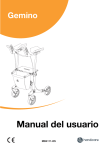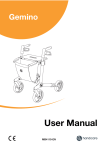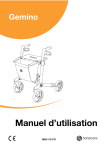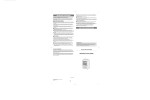Download User Manual
Transcript
Gemino User Manual MB4111-EN Introduction Congratulations on your choice of new rollator Quality and functionality are keywords for all Handicare products. We are very keen to receive any feedback from you about your experiences of using this rollator. In this way we can produce an even better product. For your own safety, and in order to derive the greatest benefit from the features of your new rollator, we recommend that you read this user manual carefully before you start to use the rollator. Handicare Gemino in brief Handicare Gemino Walker is designed for indoor use. It is easy to adjust Handicare Gemino to the needs of individual users. Handicare Gemino is equipped with stable wheels that roll easily and brakes that are easy to use. Handicare Gemino can be folded for easier transport. It can stand when in the folded position and can therefore also be used for support when folded. www.handicare.com 2 MB4111-EN Contents Introduction...................................................................................2 Contents ........................................................................................3 Parts of the rollator ......................................................................4 When you receive your Handicare Gemino ...............................5 Using the rollator ..........................................................................6 Adjusting the rollator .................................................................10 Safety ...........................................................................................13 Maintenance ...............................................................................14 Labelling ......................................................................................16 Technical specifications ............................................................17 Procedure for reuse ...................................................................19 Accessories ................................................................................20 Guarantee....................................................................................21 MB4111-EN 3 Parts of the rollator In order to be able to read and understand this manual it is important that you familiarise yourself with the most common terms that we use for the different parts of the rollator. Have a look at figure 1 and note the relevant parts on your rollator. The parts of your rollator may vary from the rollator shown in figure 1. Pushing handle Brake lever Seat Basket Brake cable Side frame Hinge Tipping bar Catch for height adjustment Strap for folding the rollator Brake block with side deflector Lifting handle and holder for basket Figure 1 4 MB4111-EN When you receive your Handicare Gemino Assembly Figure 2 The rollator is supplied complete as standard. All you need to do is: • Unfold the rollator. See page 9 • Set the pushing handles to the correct height. See page 10 • Fit and adjust any accessories Figure 2 Packaging Take the packaging to an appropriate waste reception centre. The plastic and cardboard used in the packaging can be recycled. MB4111-EN 5 Using the rollator Driving brake Figure 4 Always check that the brakes are working before starting to use the rollator. • If you need to brake while pushing the rollator, squeeze the brake lever a little to reduce your speed. • Do not push the rollator with the brakes in the locked position. If you attempt to push the rollator with force when the brakes are locked or partly locked, this will result in damage to the tyres and brakes, which in turn can stop the brakes working properly. • Do not use the rollator if the brakes are defect. Driving brake Parking brake Figure 4 Parking brake Figure 4 • Push the brake lever down to activate the parking brake. You will hear a faint click when the parking brake has activated. • Pull the brake lever up to release the parking brake. Always use the parking brake when you stop or park the rollator. Always use the parking brake when you are going to sit on the seat. Seat Figure 5 • Ensure that the parking brake is on before you sit down. • Always sit with your back towards the direction of travel. • A sling-style backrest for better support can be purchased as an accessory. Do not lean on the strap between the push handles. Back support is available as accessory. Figure 5 6 MB4111-EN Using the rollator Walking with the rollator Figure 6 For the best support and the safest movement, walk fully upright with the rollator near your body. Tuck your bottom in. Look forwards, not downwards. Do not push the rollator a long way in front of your body. This can lead to falls and incorrect loadings. Figure 6 MB4111-EN 7 Using the rollator Negotiating obstacles, tipping bar Figure 7 Step on the tipping bar to tip up the front wheels of the rollator when you need to negotiate kerbs, sills or other obstacles. Figure 7 Side deflector Figure 8 Gemino is equipped with a side deflector , which prevents the back wheel from catching on protruding obstacles such as door frames and corners. Figure 8 8 MB4111-EN Using the rollator Folding the rollator Figure 9 The rollator locks automatically in the completely folded position. • Pull the strap to fold up the rollator. Be aware of the danger of trapping injuries when folding and unfolding the rollator. Figure 9 Unfolding the rollator Figure 10 The rollator locks automatically in the completely open position. • Pull the operating handles apart. • Press the side bars down until you hear a small click in the fully unfolded position. • Before using the rollator, make sure that the folding mechanism is locked in place. Figure 10 Lifting and carrying the rollator Figure 11 The lifting handles are most easily accessible when the rollator is folded. • Fold the rollator before lifting it, as this is the best way to lift it and the easiest because of the relation between weight and the lifting handles. Figure 11 MB4111-EN 9 Adjusting the rollator Height of the pushing handles Figures 12 and 13 To achieve the correct pushing position and avoid incorrect loadings, the pushing handles must be adjusted so that the user walks upright into the rollator and does not need to bend his or her back while pushing. Figure 13 • Lift the catch. • Push or pull the pushing handle to the correct height. • Release the catch. The pushing handle will now be automatically locked at the correct height. Figure 12 Depth of the pushing handles Figures 14 To achieve the correct pushing position, the depth of pushing handles must be adjusted. • Loosen the locking wheel . • Push/pull the pushing handle to the correct position. • Tighten the locking wheel . 10 Figure 14 MB4111-EN Adjusting the rollator Memory function for correct height of pushing handle Figure 15 The memory function enables you to quickly set the pushing handle back to the correct height if the height has been changed during transport etc. • Before activating the memory function, you must decide the correct height of the push handles • Loosen the screw using a 3 mm Allen key. • Lift out the pushing handle. • Turn the memory block through 90° and pull it right out. • Position the block at the correct height. Now the pushing handle cannot be positioned higher than the point at which the memory block has been set, but you can still push it right down for transport. • Tightly close the height adjustment catch once you have positioned the pushing handle correctly. • Retighten the screw . Figure 15 MB4111-EN 11 Adjusting the rollator Adjusting the brakes Figure 16 The brakes should be adjusted so that they brake all wheels equally. The distance between the brake block and the brake should be about 2 mm. When the parking brake is applied, the brake block should not press in to the rubber of the wheel, as this can damage the wheel. • Loosen the locking nut . • Adjust the brake by screwing the cable adjuster nut inwards or outwards. • Test the brakes by spinning the wheel and squeezing the brake levers. The wheels should run easily. Figure 16 12 MB4111-EN Safety • Always check that the brakes are working before using the rollator. • Make sure that the folding mechanism is locked in place after unfolding the rollator. • Always use the parking brake when stopping or parking. • Ensure that the rollator has been adjusted to the correct height to avoid incorrect loadings and falls. Do not push the rollator a long way in front of your body. • Be aware of the possibility of trapping injuries; avoid putting your fingers between the rollator’s moving parts. Pay particular attention when folding and unfolding the rollator. • Users must move among pedestrians and not on trafficked roadways. Use reflectors when using the rollator outdoors. • Do not use the rollator for any purpose other than that it was intended for. It must not be used to transport people or heavy loads. • Do not lean on the strap between the push handles. Back support is available as accessory. • Be careful when there are children in the vicinity. Do not let children play with the rollator. • The maximum user weight for the rollator is 150 kg. • The maximum weight to be held in the basket is 5 kg. • You should regularly inspect the rollator to make sure that all screws, bolts and other fastenings are secure. • Avoid making modifications or conversions to the rollator that could affect its safety, which is designed into the rollator’s construction. • Do not use the rollator if it is damaged or has any malfunction. Contact your dealer for repair. • Do not use any accessories that is not approved by Handicare. MB4111-EN 13 Maintenance Maintenance described in this section can be carried out by the user. Other maintenance work should be carried out by qualified personnel at the supplier in your municipality or at the technical aids centre. For information about repairs and servicing, please contact the technical aids centre in your county. Washing the frame The frame should be washed regularly with warm soapy water. If the frame is very dirty, a degreasing agent may be used. The frame may be washed with a high-pressure hose. If you use this method, avoid directly spraying the ball bearings. Dry the rollator thoroughly after washing it or after it has been used in rainy conditions. If a degreasing agent is used, moving parts should be greased afterwards. Cleaning the brakes Clean the brake blocks and brake springs regularly. Cleaning the basket The basket can be removed and washed separately. Hand wash at 40°. Conditions that could damage the rollator The rollator should not be used at temperatures below -35 °C or above 60 °C. No specific requirements are made in connection with humidity or air pressure. No further requirements are made regarding storage conditions. Screws and nuts Screws and nuts can become loose over time. Therefore, remember to check and if necessary retighten all screws and nuts on a regular basis. A threadlocking product, such as Loctite Blue No. 243, may be used. If self-locking nuts have been removed they lose some of their locking ability and should be replaced. Locking mechanism If the locking mechanism for folding/unfolding becomes stiff after a period of time, we recommend lubricating the surfaces with Vaseline. 14 MB4111-EN Maintenance Disinfection Disinfection should only be carried out by qualified personnel. The rollator can be disinfected using a disinfectant containing 70–80 per cent ethanol. Do not use disinfectants that contain bleach or phenols. Regular inspection • Check that the brakes function correctly. Adjust if necessary. • Check that the wheels are in good condition and that they have not been damaged. • Ensure that the rollator is clean and that all moving parts function correctly. • Check and if necessary adjust all screwed connections. Repairs Apart from small repairs to paintwork, the replacement of wheels and the adjustment of the brakes, all repairs must be undertaken by qualified personnel at the supplier in your municipality or at the technical aids centre. For information about repairs and servicing, contact the technical aids centre in your county. Storage Store the rollator in a standing position. The rollator can be kept outdoors. Transport Fold the rollator before transport. It should be lifted and carried using the lifting handles (see page 9). Never lift the rollator by the brake cables or the seat strap. MB4111-EN 15 Labelling Product name Measures FOR INDOOR USE Max. user weight 69-88 cm CE mark Production year and month Serial number Gemino 30 16 Gemino 30 M MB4111-EN Technical specifications Specifications Total height, from surface to top of underarm support Total length Total width Width between pushing handles Seat height Height folded Length folded Width folded Turning circle Front/rear wheels Total weight (without basket) Max. user weight Max. weight in basket Recommended user height Dimensions Gemino 30 Walker Dimensions Gemino 30 M Walker 98-115 cm 65 cm 61 cm 25,5 cm 62 cm 97 cm 65 cm 35,5 cm 84 cm 20 x 3,6 cm 10,6 kg 150 kg 5 kg 150 - 200 cm 84 - 100 cm 65 cm 61 cm 25,5 cm 55 cm 89 cm 65 cm 35,5 cm 84 cm 20 x 3,6 cm 10,4 kg 130 kg 5 kg 135 - 170 cm Figure 17 MB4111-EN 17 Technical specifications Materials used The rollator and most of the parts are manufactured using a special aluminium alloy. Areas of application The rollator is intended for indoor use on a flat and firm surface. It has been developed for individuals with reduced muscle strength, reduced movement, reduced mobility and reduced stability. Waste handling Waste relating to packaging, parts of the rollator or the rollator itself can be treated as general waste. The main component of the rollator is aluminium, which can be melted down for reuse. The plastic and cardboard used in the packaging can be recycled. The product fulfils the requirements of the EU-Directive 93/42 EEC for medical devices. Based on the classification rules in Attachment IX of this directive the product is classified into class I. The declaration of conformity has been done under the own responsibility of Handicare based on the Attachment VII of this directive. 18 MB4111-EN Procedure for reuse Checklist before reuse The rollator is intended/fit for reuse. Check that the brakes function correctly Adjust the brakes if necessary Check that the brake levers are in the correct position Clean the brake blocks Clean the brake springs Check that the wheels are in good condition and that they have not been damaged Replace any damaged or worn wheels Check that all moving parts are working Check and if necessary adjust all screwed connections Check the wheel suspension and change if necessary Ensure the rollator is clean and hygienic MB4111-EN 19 Accessories • • • • • • • • • • • Crutch holder Table Umbrella Backrest Advanced bag Bag for oxygen cylinder Back support Slow down brake Light Universal bracket One hand brake 20 MB4111-EN Guarantee Description: Frame/chassis Warranty term: 5 years Covered A 5-year guarantee for the product is valid from the date of delivery. Handicare guarantees that the product shall not have any defects with regard to material and design, and that it fulfils all the requirements specified in the sales brochure. Handicare guarantees free repairs, maintenance and change of any defect parts, provided that the damage was caused during normal use as described in the user manual. All part exchanges, service and claims made under the following limited guarantee must be presented to Handicare AS in writing within 45 days of the need for this arising in order to be entitled to compensation. The warranty is exclusively at Handicare’s discretion. Not covered Below mentioned situations are not covered (Exclusions and limitations): Equipment that is adjusted, modified or items added by persons other than Handicare or an approved representative will not be covered by this guarantee. Tyres, tubes and upholstery are not covered by this guarantee. Any damage to accessories will not be covered by this guarantee. Equipment that is not treated with due care or is used in a way that is inconsistent with the guidelines of this user manual will not be covered by the guarantee. Lack of or improper maintenance. Cosmetic appearance of items will change as a result of use and are not covered by this warranty. Corrective action can be either repair, replacement or exchange. Labour, call-out and shipping. After the corrective action, the original warranty period will not be extended. Any damage to items added to the Handicare supplied equipment, caused by the Handicare supplied equipment. And any damage to the Handicare supplied equipment by the additional equipment. Batteries (covered by the battery manufacturer’s standard warranty) . Circumstances beyond our control (floods, fires, etc.). MB4111-EN 21 Guarantee Description Warranty term Examples Options/ accessories 2 year (standard) Basket, umbrella, etc. Not being Service Part or Consumable Part. Service Parts Standard New: 1 year after invoice Repaired: 90 days after invoice Brake handles, height adjustment mechanism, wire stocking etc. Consumable parts Standard 40 days after invoice Brake block, brake wire, wheels, seat sling, basket and grip handles, bearings, etc. Covered Not covered Defects in materials and workmanship Below mentioned situations are not requiring corrective action to maintain covered: product’s specification. Equipment modified or items added by others Warranty is exclusively at Handicare’s than Handicare. discretion. Cosmetic appearance of items will change Corrective action can be either repair, as a result of use and are not covered by this warranty. replacement or exchange. After the corrective action, the original warranty period will not be extended. Labour, call-out and shipping. Any damage to items added to the Handicare supplied equipment, caused by the Handicare supplied equipment. And any damage to the Handicare supplied equipment by the additional equipment. Any use of the equipment outside the criteria published in the Handicare sales brochures, or beyond the manner in which a prudent person would normally use the equipment (i.e. Abuse, misuse or negligence). Lack of or improper maintenance. Batteries (covered by the battery manufacturer’s standard warranty). Circumstances beyond our control (floods, fires, etc). 22 MB4111-EN Warning: The content of this user manual is only intended as information. This information may be changed without warning and must not therefore be interpreted as an obligation on the part of Handicare. Handicare is not responsible, either legally or financially, for any errors or inaccuracies that may appear in this user manual. All products that are mentioned in this user manual are registered trademarks and cannot be used in other contexts without the consent of Handicare. MB4111-EN 23 B – November - 2011 – Handicare Manufactured by: Handicare www.handicare.com






























